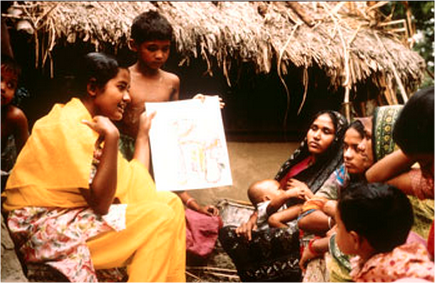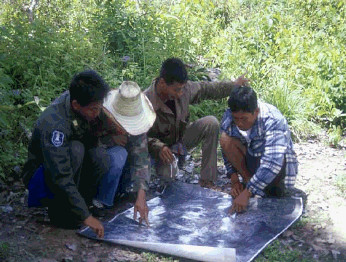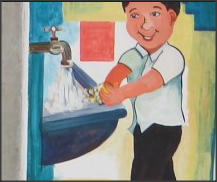Participatory methods

Participatory methods are designed to build self-esteem and a sense of responsibility for one’s decisions. They are designed for planning at community level and can be useful for identifying positive and negative behaviours related to hygiene. Participants learn from each other and develop respect for each other’s knowledge and skills.
A participatory approach brings together representatives of all the local stakeholders. This is often a diverse group of users, health workers, NGO's, etc, who might not usually work together, might come from different backgrounds, and have different values and interests. A constructive and democratic group learning and action planning process is initiated, often using visual methods of communication.
| Community mapping, transect walks, focus group discussions, gender role analysis, use of drawings, posters, role-play, theatre, and songs are examples of participatory methods. |
There are lots of participatory tools/techniques available to help guide the process. Three of the most popular approaches (overlapping rather than competing) are:
- PHAST (Participatory Hygiene and Sanitation Transformation) developed in Eastern and Southern Africa in the mid-late 1990s, it consists of a participatory approach in which people learn about their situation, make plans to improve this and then change their behaviour. Special techniques, such as mapping and ranking, are used for this process of self-discovery and analysis. The approach can be used where initial latrine coverage is low.
- SARAR (Self-esteem, Associative strength, Resourcefulness, Action planning, Responsibility) stimulates involvement in community-based activities of all kinds, not only by the more prestigious and articulate participants (such as community leaders or senior staff), but also by the less powerful, including non-literate community members.
- PRA (Participatory Rural Appraisal) a generalized description which covers a wide range of techniques especially aimed at involving communities in decision-making and self-assessment and in the development of stakeholder partnerships.
- NETSSAF (Network for the development of Sustainable Approaches for large scale implementation of Sanitation in Africa). A participatory planning approach that started in June 2006 and sponsored by the European Commission. It's goal was to identify sustainable sanitation systems in peri-urban and rural areas. Focusing on seven steps for the planning and implementation of sanitation programmes in a community, the approach targets planners in West Africa. The approach was developed by 19 organizations from West Africa and Europe.
- A second result of the NETSSAF project was the yellow pages database, which provides information for:
- providers of complete sanitation systems or individual components for the collection, transportation, treatment and reuse of waste
- providers of design, planning and general consulting on both technical and nontechnical aspects of sanitation.
Other useful tools or activities are:


- A focus group discussion
A skilled facilitator assembles representative groups from the community and creates an atmosphere where individuals feel free to express opinions openly on topics such as the environmental problems caused by excreta and how they can be mitigated. The facilitator is armed with key questions, but the conclusions emerge from the groups' open discussions and lead to ideas for action. Focus groups are helpful in the formative research phase, identifying the target practices and key messages for the different groups.
- A neighbourhood social map
In open meetings, local women and men have made a social map of their whole settlement (in small communities) or neighbourhood (in large communities). The techniques used depend on the levels of development. People draw in the soil, they fingerpaint or draw on paper, or use cut-and paste techniques. Techniques that require implements such as pens and scissors are less suitable for people without or with low literacy, often the women and the poor. Mapping can be used for many things, from what kind of families have and use what types of latrines, water sources or hygiene related skills to whether women and men from different classes and sections have equal access to education and training.
A local team of women and men systematically walks through a cross-section of their settlement, reviews good and bad situations and notes these in their cross-section diagram.
- A household and/or school hygiene self-survey
A survey is planned and implemented by a team of local women and men inhabitants or parents, teachers and students helped by a local health or NGO worker.
- Lists and tables (matrices)
Another technique is to list households which, for example, have and do not have certain improved water supply, sanitation or hygiene facilities. The number of households with and without facilities are then noted in a large table for all these facilities. Numbers may be written as figures, but non-literate or mixed groups usually use markings (e.g. tally marks), matchsticks, beans or pebbles. The table is sometimes adjusted for poverty. The group analyses the findings ("who are haves and have nots and why?"). They also make plans for improvements. They set priorities, decide on strategies, analyse human and financial resources, make plans, list activities to implement the plans, identify women and men to carry out these activities, divide tasks, based on skills and workloads, make workplans and start implementation. For all these activities, other participatory tools/techniques are available.
Videos, examples & links
in DRC, Introduction |
- The Functional Sanitation Ladder. The sanitation ladder was originally a tool that developed from participatory approaches such as Participatory Rural Appraisal (PRA) and Participatory Hygiene and Sanitation Transformation (PHAST). The ladder aimed at providing community members with a visual guide to different sanitation options, providing information on a range of factors (e.g. cost, convenience, upgradeability etc.) in order to facilitate household and communal sanitation planning and decision making.
- PLA Notes, a periodical published by the International Institute for Environment and Development (IIED) has regular features about tools for PLA (Participatory Learning and Action) in a range of different situations. One issue is devoted to PLA in Community Water Management.
- Zimbabwe's "Health Clubs" give free courses on health and hygiene issues to anyone wishing to attend. They generate commitment and spread awareness of critical risks, resulting in measurable improvements in hygiene behaviours. PDF: Scaling up the Community Health Club Model to meet the MDGs for Sanitation in rural and urban areas: Case Studies from Zimbabwe and Uganda.
- The NORWASP project in Ghana uses a "Health and Hygiene Game" to stimulate awareness.
- IRC - Just stir gently : the way to mix hygiene education with water supply and sanitation includes a table giving the pros and cons of different visual tools that can be prepared in advance for facilitating community group discussions.
- The Participatory Hygiene and Sanitation Transformation (PHAST). The World Bank.
- SARAR: Self-esteem, Associative strength, Resourcefulness, Action planning and Responsibility. Poverty Reduction & Equity - The World Bank.
- Participatory Rural Appraisal. Social Analysis - The World Bank.
- Survey - Water, sanitation and hygiene: Findings of a household survey conducted in 18 districts of Mozambique. UNICEF, January 2009.
- PALS (Participatory Action Learning System) aims to empower people (particularly the very poor, as individuals and communities) to collect, analyse and use information to improve and gain more control over their lives.
- Mandakini Pant, Participatory Training Methodology and Materials. UNESCO.
- Word Doc: Review of participatory sanitation planning tools. Produced by the NETSAFF project.
- PDF: Participatory Methodology Facilitation Guide. WaterAid. 2002.
- IRC - Somali PHAST step-by-step guide (2007).
- WHO - Participatory hygiene and sanitation transformation: A new approach to working with communities (2000 reprint).
- WHO - PHAST step-by-step guide: A participatory approach for the control of diarrhoeal diseases (1998). (French version also available)
- PDF: Simpson-Herbert, M., Sawyer, R. & Clarke, L. (1997). The PHAST initiative.
- PDF: WHO - Experiences in pilot countries (Botswana, Kenya, Uganda, Zimbabwe).
- Environment and health: WHO proposes a strategy for the African region.
- PDF: Kvarnström, E. & Petersens, E. (2004). Open planning of sanitation systems.
- PDF: International Water Association. Sanitation 21, Simple Approaches to Complex Sanitation.
- EAWAG (2005). The Household-Centred Environmental Sanitation (HCES) approach (available in English, Spanish, French).
- PDF: Kar, K. (2005). Practical Guide to Triggering Community-Led Total Sanitation (CLTS).
- Community Led Total Sanitation.
- Word Doc: Review of the existing participatory sanitation planning.
Acknowledgments
- FIETS sustainability approach. Dutch WASH Alliance.
